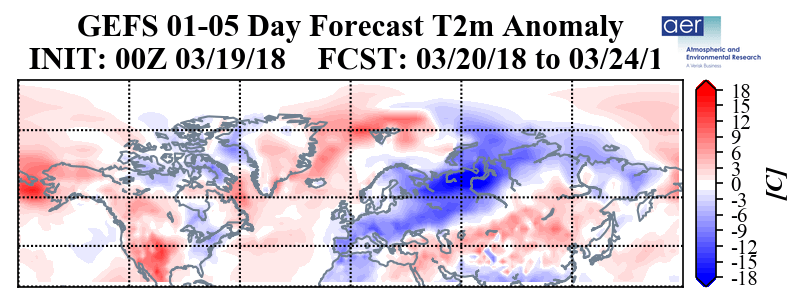Dr. Judah Cohen has posted his outlook on the spring in Arctic and NH at his AER blog. Exerpts below with my bolds.
Summary
- The Arctic Oscillation (AO) is currently slightly negative and is predicted to trend positive but never to stray too far from neutral . The bulk of the atmospheric response to the polar vortex (PV) disruption, which occurred in February seems to have already occurred though some lingering influences continue.
- The current negative AO is reflective of positive pressure/geopotential height anomalies across the North Atlantic side of the Arctic and negative pressure/geopotential height anomalies across the mid-latitudes of the North Atlantic.

- The North Atlantic Oscillation (NAO) is currently also negative with positive pressure/geopotential height anomalies across Greenland and negative pressure/geopotential height anomalies across the mid-latitudes of the North Atlantic. The forecasts are for the NAO to also trend positive and then straddle neutral the next two weeks.
- The PV is predicted to linger across Western Siberia over the next two weeks. This will contribute to persistent troughing/negative geopotential height anomalies across northern Eurasia including Europe. This will allow cold temperatures now stretching from Northern Asia to Europe and the United Kingdom (UK) to mostly remain in place with some fluctuation in intensity over the next two weeks.
- Currently ridging/positive geopotential height anomalies south of the Aleutians is contributing to troughing/negative geopotential height anomalies in the Gulf of Alaska and the West Coast of North America with additional ridging/positive geopotential height anomalies in central North America and more troughing/negative geopotential height anomalies downstream across the Eastern United States (US). This pattern in general favors normal to above normal temperatures for western North America and normal to below normal temperatures in the Eastern US.
- However the pattern across North America is predicted to be slowly progressive with time and become much less amplified. This will lead to a general weakening of temperature anomalies for much of the continent, though warm temperature anomalies in the Western US are predicted to remain consistent in magnitude.
- I continue to believe that the ongoing stratospheric PV displacement in Western Siberia favors overall cold temperatures for Siberia that extend into Europe as well as a cold bias in temperatures in the Northeastern US. These cold temperature anomalies are likely to persist as long as the stratospheric PV lingers across Siberia.
